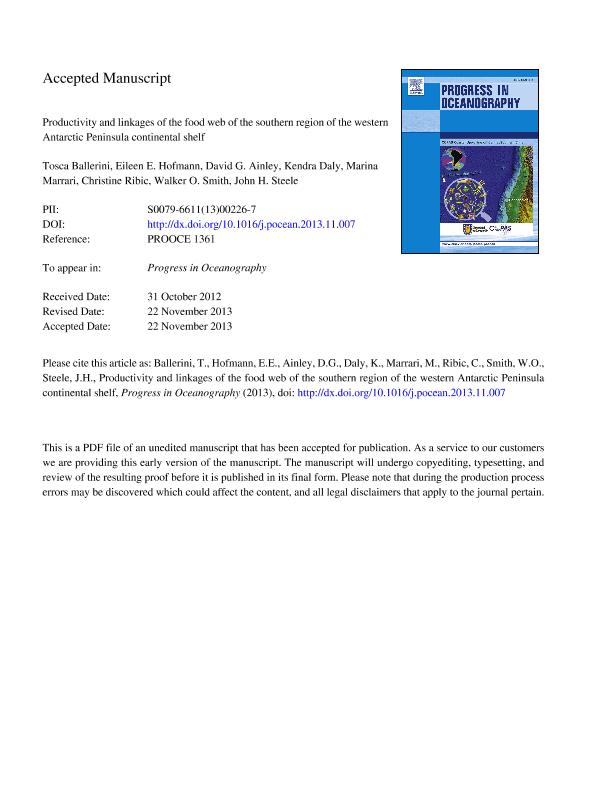Mostrar el registro sencillo del ítem
dc.contributor.author
Ballerini, Tosca
dc.contributor.author
Hofmann, Eileen E.
dc.contributor.author
Ainley, David G.
dc.contributor.author
Daly, Kendra
dc.contributor.author
Marrari, Marina

dc.contributor.author
Ribic, Christine A.
dc.contributor.author
Smith, Walker O.
dc.contributor.author
Steele, John H.
dc.date.available
2019-11-20T23:09:41Z
dc.date.issued
2014-03
dc.identifier.citation
Ballerini, Tosca; Hofmann, Eileen E.; Ainley, David G.; Daly, Kendra; Marrari, Marina; et al.; Productivity and linkages of the food web of the southern region of the western Antarctic Peninsula continental shelf; Pergamon-Elsevier Science Ltd; Progress In Oceanography; 122; 3-2014; 10-29
dc.identifier.issn
0079-6611
dc.identifier.uri
http://hdl.handle.net/11336/89355
dc.description.abstract
The productivity and linkages in the food web of the southern region of the west Antarctic Peninsula continental shelf were investigated using a multi-trophic level mass balance model. Data collected during the Southern Ocean Global Ocean Ecosystem Dynamics field program were combined with data from the literature on the abundance and diet composition of zooplankton, fish, seabirds and marine mammals to calculate energy flows in the food web and to infer the overall food web structure at the annual level. Sensitivity analyses investigated the effects of variability in growth and biomass of Antarctic krill (Euphausia superba) and in the biomass of Antarctic krill predators on the structure and energy fluxes in the food web. Scenario simulations provided insights into the potential responses of the food web to a reduced contribution of large phytoplankton (diatom) production to total primary production, and to reduced consumption of primary production by Antarctic krill and mesozooplankton coincident with increased consumption by microzooplankton and salps. Model-derived estimates of primary production were 187-207gCm-2y-1, which are consistent with observed values (47-351gCm-2y-1). Simulations showed that Antarctic krill provide the majority of energy needed to sustain seabird and marine mammal production, thereby exerting a bottom-up control on higher trophic level predators. Energy transfer to top predators via mesozooplanton was a less efficient pathway, and salps were a production loss pathway because little of the primary production they consumed was passed to higher trophic levels. Increased predominance of small phytoplankton (nanoflagellates and cryptophytes) reduced the production of Antarctic krill and of its predators, including seabirds and seals.
dc.format
application/pdf
dc.language.iso
eng
dc.publisher
Pergamon-Elsevier Science Ltd

dc.rights
info:eu-repo/semantics/openAccess
dc.rights.uri
https://creativecommons.org/licenses/by-nc-sa/2.5/ar/
dc.subject
Antarctic krill
dc.subject
Climate change
dc.subject
Donor-controlled model
dc.subject
Food-web
dc.subject.classification
Biología Marina, Limnología

dc.subject.classification
Ciencias Biológicas

dc.subject.classification
CIENCIAS NATURALES Y EXACTAS

dc.title
Productivity and linkages of the food web of the southern region of the western Antarctic Peninsula continental shelf
dc.type
info:eu-repo/semantics/article
dc.type
info:ar-repo/semantics/artículo
dc.type
info:eu-repo/semantics/publishedVersion
dc.date.updated
2019-10-28T14:34:42Z
dc.journal.volume
122
dc.journal.pagination
10-29
dc.journal.pais
Países Bajos

dc.journal.ciudad
Amsterdam
dc.description.fil
Fil: Ballerini, Tosca. Old Dominion University; Estados Unidos
dc.description.fil
Fil: Hofmann, Eileen E.. Old Dominion University; Estados Unidos
dc.description.fil
Fil: Ainley, David G.. H.T. Harvey & Associates; Estados Unidos
dc.description.fil
Fil: Daly, Kendra. University of South Florida; Estados Unidos
dc.description.fil
Fil: Marrari, Marina. Consejo Nacional de Investigaciones Científicas y Técnicas; Argentina. University of South Florida; Estados Unidos
dc.description.fil
Fil: Ribic, Christine A.. University of Wisconsin; Estados Unidos
dc.description.fil
Fil: Smith, Walker O.. The College of William and Mary; Estados Unidos
dc.description.fil
Fil: Steele, John H.. Woods Hole Oceanographic Institution; Estados Unidos
dc.journal.title
Progress In Oceanography

dc.relation.alternativeid
info:eu-repo/semantics/altIdentifier/doi/https://doi.org/10.1016/j.pocean.2013.11.007
dc.relation.alternativeid
info:eu-repo/semantics/altIdentifier/url/https://www.sciencedirect.com/science/article/pii/S0079661113002267
Archivos asociados
